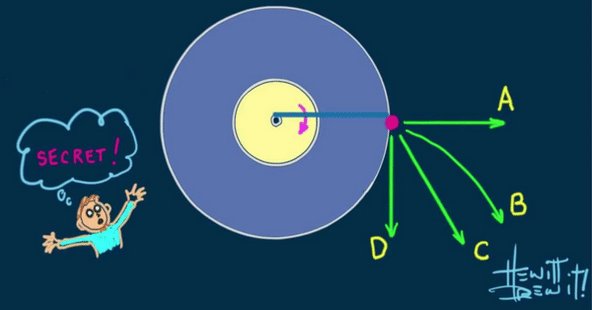System of Particles and Rotational Motion forms an important part of Physics and is a major scoring chapter. Check here all the major concepts and formulas related to System of Particles and Rotational Motion.
- Introduction
- Center of Mass
- Characteristics of the Centre of mass
- Center of Gravity
- Motion of centre of Mass
- Vector Product or Cross Product of two vectors
- Torque
- Angular Momentum
- Rotational Motion
- Axis of Rotation
- Couple
- Moment of Inertia
- Major Points to Note
- Radius of Gyration
- Theorem of Parallel Axes
- Theorem of Perpendicular Axes
- Rolling Motion
- Law of Conservation of Angular Momentum

Introduction
What is a rigid body? It is a body that has an unchanging shape and is perfectly definite. In a rigid body, the distance between the pairs of particles does not change. As per the motion of a body, even when two or more bodies are in relative movement to each other, there will be a point that will move in the same direction as the particle if it is subjected to the same net force. This point is known as the center of inertia or the center of mass. Altogether, we can consider the general motion of an extended body as the sum of the translational motion of its center of mass plus rotational, vibrational, or another type of motion about its center of mass.
Let’s take an example of a diver to understand this concept. When the diver moves, there is a parabolic path followed by the center of mass even when the diver rotates. Now, this is the same path that is followed by a particle when a force of gravity is applied to it.
Center of Mass
Considering the system of particles, the center of mass can be termed as the center where the entire mass of a system is collected for translational motion. This means that if all the external forces that act on a system of bodies are applied at the center of mass, then there will be no effect on the state of rest or motion of the body systems. The center of mass for a system is also known as its balancing point. In the case of a 2-particle system, the center of mass will always be at the line where the 2 particles are joined and somewhere in between both particles.
Characteristics of the Centre of mass
Some of the major Characteristics of the Centre of mass are listed in the points below:
1. The system of particles' center of mass is solely dependent on the masses and relative locations of the particles. It depends on the shape and the mass distribution of an object with continuously dispersed mass.
2. The system's sum of moments of masses about its center of mass is zero, or mixi = 0.
3. The location of the mass center does not require the presence of a mass particle. A uniform ring's center, where there are no mass particles, is where its center of mass is located.
4. The reference frame utilized to find the center of mass has no bearing on where it is.
Also Read:
- Physics Class 12 Units and Measurements
- Physics Class 12 Motion in a Straight Line
- Physics Class 12 Laws of Motion
Center of Gravity
Center of gravity is also similar to the center of mass. The center of gravity refers to that point of a system where the gravitational force is acting altogether. The only difference between the center of mass and the center of gravity is based on their concepts but in a practical sense, these both are at the same point.
Motion of centre of Mass
The center of mass for a system of particles moves in such a way that the entire mass of the body is collected at the center of mass and all the external forces are acting on that collection point. We can calculate the velocity of the center of mass for a system of two particles (m1 and m2) with respective velocities (v1 and v2) through the formula given below:
One thing to note here is that if there is no external force acting on the body, then there will be a constant momentum for the center of mass. This means its velocity will be constant and the acceleration will be zero.
i.e., MVcm = constant.
Vector Product or Cross Product of two vectors
Torque
The moment of force is known as the Torque. The torque acting on a particle is known as the product of the magnitude of the force acting on the particle and the perpendicular distance of the application of force from the axis of rotation of the particle.
Angular Momentum
Angular momentum, which is also known as a moment of momentum, is a vector quantity. The magnitude of angular momentum is equal to the product of the perpendicular distance of the line of action of momentum from the axis of rotation and the magnitude of momentum. Also, the direction of angular momentum is perpendicular to the plane that has the perpendicular distance and the momentum.
Rotational Motion
The translational motion of single particles or rigid bodies, that is, bodies whose pieces are fixedly related to one another regardless of the applied force has been the subject of our previous research. No physical body is completely rigid, but many bodies such as molecules, steel beams, planets, etc. are sufficiently rigid to make their warping, bending, and vibrating behaviors irrelevant.
If each rigid body component experiences the same displacement as every other component at any given time, the rigid body is said to be moving in translation.
Rotational Motion
Every particle of a stiff body must move in a circle with the centers on the 'axis of rotation for the body to move in pure rotation. Each line will traverse the same angle in any given time interval as another line if we draw a perpendicular from any point on the body to the axis.
Plane Motion
The motion of the rigid body is referred to as plane motion if any particle's motion is constrained to a plane and the planes of motion of various particles are either the same or parallel. The rotation axis maintains its orientation in space while moving on a plane.
Axis of Rotation
We consider a rigid body to be in rotation when every point of the mass of that body is in a circular path that has the same angular speed but a different radius. The circular motion of all the mass of that body will have a common center. The line that passes through that common center is known as the axis of rotation.
We will say that a rigid body is in equilibrium when the body will remain in its uniform motion or the position of rest when under the action of forces.
In the case of translational motion, the vector sum of all the forces that are acting on the body ought to be zero. Whereas, in rotational motion, the vector sum of all the torques of the forces acting on the body around a reference point ought to be zero. These two conditions must be fulfilled for a state of complete equilibrium.
Couple
Two equal & opposite forces form a couple when they are acting on the same body but have a different line of action. For a couple, the net force is zero but they implement a torque and create a rotational motion.
Quick Links for Preparation:
Moment of Inertia
Moment of Inertia refers to the rotational inertia of a rigid body.
We can define the moment of inertia for a body as the sum of the products of the masses of the particles constituting the body and the square of their respective perpendicular distance from the axis.
We can calculate the moment of inertia using the following formula:
Major Points to Note
- Moment of inertia has dimensions [ML2] and SI unit kgm2.
- It is not a vector as by changing the sense of rotation its value is not changed. It is also not scalar as it has different values in different directions (i.e., about different axes). It is a tensor.*
- It depends on the axis of rotation and for a given axis, depends on mass, shape and size of the body.
- For a given shape, size, mass and axis, it depends on the distribution of mass within the body about the axis. Farther the constituent particles of a body are from the axis of rotation, larger will be its moment of inertia.
- Moment of inertia of a part of a rigid body (symmetrically cut from the whole mass) is the same as that of the whole body. For example, in figure (ii) moment of inertia of the section shown (a part of a circular disc) about an axis perpendicular to its plane and passing through point ‘O’ is ½ MR square as, the moment of inertia of the complete disc, figure (i), is also ½ MR square.
Physical quantities which have no specified direction but different values in different directions are called tensors. Density ρ, refractive index μ, dielectric constant K, electrical conductivity σ, stress and strain, etc. which are normally scalars, in anisotropic media, assume different values in different directions, so become tensors.
Radius of Gyration
Radius of Gyration is known as the distance of a body’s point from the axis of rotation where the total mass of the body is supposed to be collected. The moment of inertia of such a point about the axis of rotation will be the same as determined by the actual mass distribution of the body. For instance, if the whole mass of a body is concentrated at K distance from the axis of rotation, then the moment of inertia I will be expressed as I = MK2.
Theorem of Parallel Axes
As per the theorem of parallel axes, the moment of inertia for a body about an axis is same as the moment of inertia about a parallel axis which goes through the center of mass Icm, plus Ma2 where M is the mass of the body and V is the perpendicular distance between the axes, i.e.,
I = Icm + Ma2
Theorem of Perpendicular Axes
As per the theorem of Perpendicular Axes, the moment of inertia I of the body about a perpendicular axis is equal to the sum of moments of inertia of the body about two axes at right angles to each other in the plane of the body and intersecting at a point where the perpendicular axis passes, i.e.,
Rolling Motion
A rolling motion refers to the combination of the translational motion and the rotational motion of a rigid body.
Law of Conservation of Angular Momentum
As per the Law of Conservation of Angular Momentum, in case there is no external couple, then the total angular momentum for a system of particles or a rigid body will be conserved.
Stay tuned to CollegeDekho for more Education News ! You can also join our Telegram Group for the latest Education news & updates!
















Similar Articles
DHE/SAMS Odisha +3 Admissions 2025: Registration, Eligibility Criteria, Selection Process, Seat Allotment, Merit List
B.Ed Admission 2025: Dates, Application Form, Eligibility, Selection Process, Fees, Top Colleges
List of Documents Required to Fill UGC NET 2024 Application Form: Image Upload, Specifications
REET Syllabus 2025 for Level 1 and 2: Download Subject-wise PDFs, Exam Pattern
Karnataka B.Ed Selection List 2024: Date, Seat Allotment Result Link, PDF Download
TS TET 2024: Exam Dates (Out), Registration (Closed), Admit Card, Results